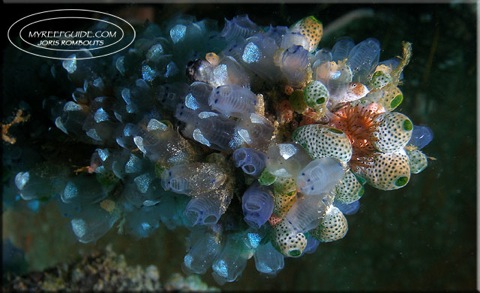
- Check the sub-map for the specimen information files -
ASCIDIANS
Ascidians are not invertebrates, but actually belong to the back-boned animals as we humans. They are more known under the name sea squirts or tunicates. There are 2300 different species of ascidians. Some live solitary, while others prefer to form colonies. Each individual member of one of these colonies is called a zooid. They are sac-like marine animals which are found in the shallow waters of all seas and oceans. Members of the Thaliacea (salp) and Larvacea swim freely in open water while all the other tunicates are not able to transfer themselves and are well attached to substrate such as rocks, dead coral and shells. The sac-like body is protected by a kind of cellulose material. Some tunicate species are transparent while others can have a more leathery look with wrinkles and warts. All sea squirts have two or more openings with a different dimension. The largest called oral siphon. The smaller opening(s) or atrial siphon is positioned more on the side of the animal, but often very close to the oral siphon. Tunicates feed by sucking in water via the oral siphon. The water flows through the mouth via the mucus-covered gills who filter plankton out of the water. Then it flows through a water chamber between the stomach and the outer skin, and leaves the animal via the smaller atrial siphon. When looking to one of the transparent tunicate specimen, you can see how the whole feeding system works.
- Check the sub-map for the specimen information files -



